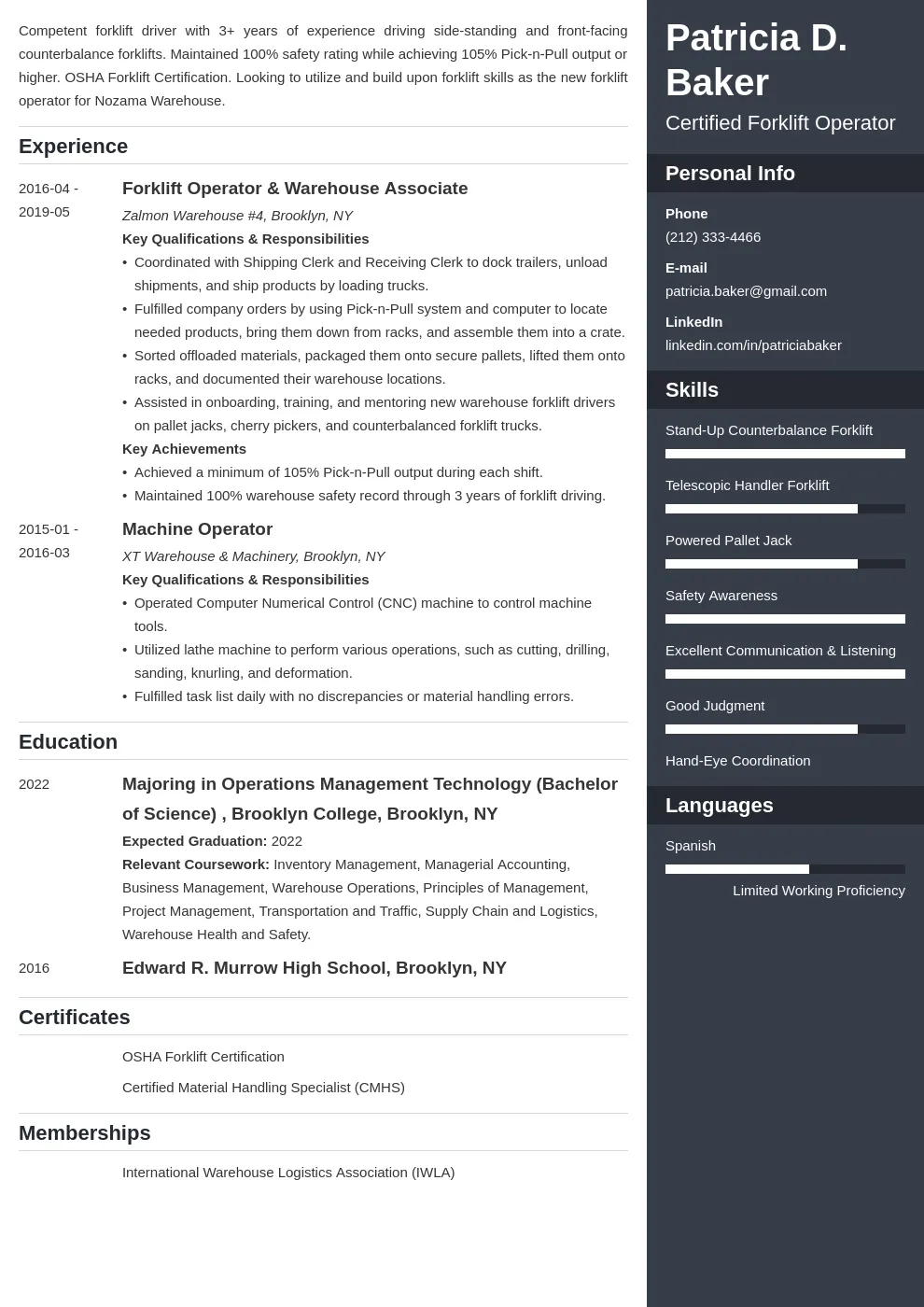Crafting Your Forklift Operator Resume
Your resume is the first impression you make on potential employers. As a forklift operator, it’s crucial that your resume is clear, concise, and effectively highlights your skills and experience. Start by choosing a professional resume format, such as a chronological or combination format. The chronological format is best if you have a consistent work history, while the combination format allows you to emphasize your skills and experience, which is beneficial if you have gaps in employment. Ensure your contact information is accurate and prominently displayed. Use a clean and easy-to-read font, and avoid clutter. The goal is to make it easy for the hiring manager to quickly grasp your qualifications. Remember, your resume is a marketing tool; it should sell your abilities and showcase why you’re the best candidate for the job. Spend sufficient time on this step, as a well-crafted resume can significantly increase your chances of getting an interview.
Highlighting Relevant Skills
In the competitive field of forklift operation, showcasing relevant skills is paramount. Your resume should feature a dedicated skills section where you can list all the competencies you possess. This section should be tailored to the specific job you’re applying for, so review the job description carefully and include the skills that the employer is seeking. Consider categorizing your skills for clarity – such as forklift operation, warehouse management, and safety protocols. Examples of skills to include are forklift operation (specific types if applicable), loading and unloading, inventory management, order picking, and equipment maintenance. Make sure to incorporate keywords from the job description to help your resume get noticed by applicant tracking systems (ATS). A well-structured skills section makes it simple for the hiring manager to quickly assess your capabilities and determine if you meet the job requirements.
Forklift Operation Skills
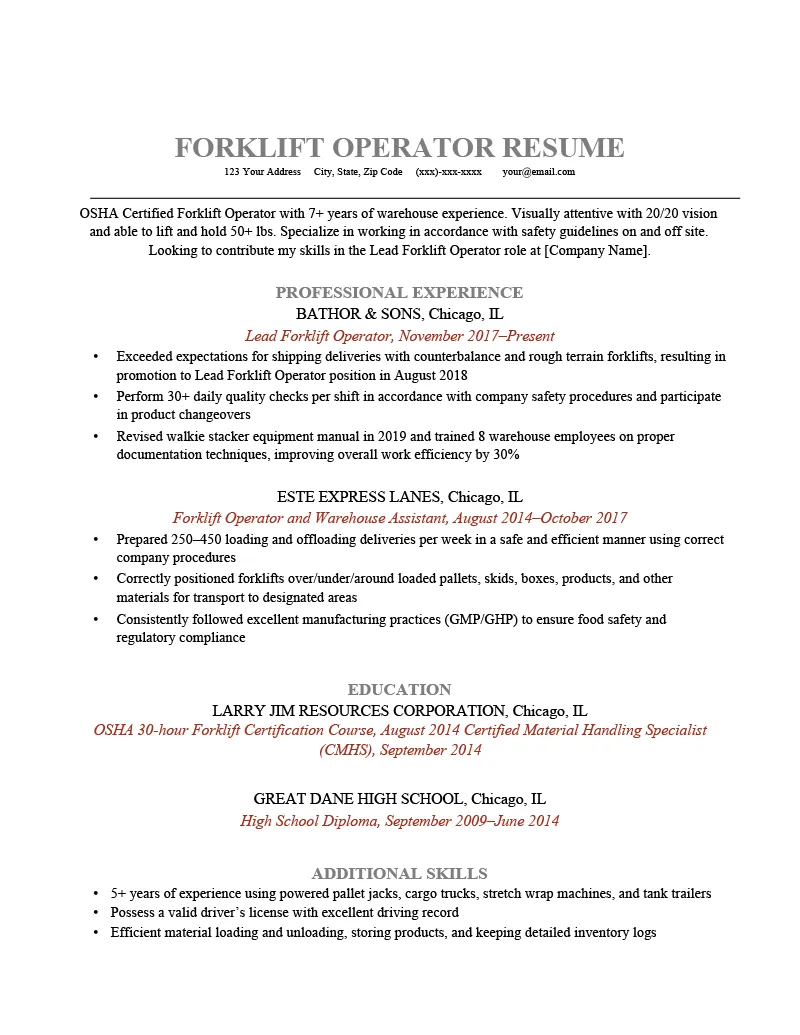
When detailing your forklift operation skills, be as specific as possible. Mention the types of forklifts you are proficient in, such as sit-down, stand-up, reach truck, or order picker. Include the years of experience operating each type. Highlight any certifications or licenses you hold, such as a forklift operator certification. Detail your proficiency in performing routine inspections and maintenance tasks. If you have experience operating in various environments (e.g., indoor, outdoor, narrow aisles), specify this. Emphasize your skills in maneuvering the forklift safely and efficiently, loading and unloading materials, and ensuring the proper storage of goods. If you have experience with specific attachments (e.g., clamps, side shifters), include those details. Your ability to safely and effectively operate a forklift is the cornerstone of your resume, so provide comprehensive information to demonstrate your expertise. Clearly communicate your understanding of operating procedures, safety regulations, and the ability to adapt to different workplace environments.
Warehouse Management
Warehouse management skills are essential for forklift operators. Highlight any experience you have with inventory management, including tasks like receiving, storing, and distributing goods. Mention your familiarity with warehouse management systems (WMS) or any software used for tracking inventory. Include your experience with order fulfillment, ensuring orders are picked, packed, and shipped accurately and on time. If you have experience with cycle counting, put that on your resume. Demonstrate your ability to organize and maintain a clean and safe warehouse environment, which is crucial for efficiency and safety. Experience in coordinating with other warehouse staff is valuable. Display your skills in handling various types of materials, including understanding different storage requirements. Highlight your ability to contribute to overall warehouse productivity and efficiency. Emphasizing your warehouse management skills will show potential employers that you are a versatile and valuable member of the team.
Safety Compliance
Safety is a critical aspect of forklift operation. Emphasize your commitment to safety compliance by listing any relevant certifications, such as OSHA forklift certification. Detail your understanding of safety regulations, procedures, and protocols. Describe your experience in conducting pre-shift inspections and identifying and reporting any potential hazards or maintenance issues. Mention your adherence to weight limits, safe lifting practices, and load stability guidelines. Include your knowledge of emergency procedures, such as what to do in the event of a tip-over or other incidents. Highlight your ability to maintain a safe work environment for yourself and others, including your awareness of pedestrian safety. Showing your strong commitment to safety compliance demonstrates that you are a responsible and reliable forklift operator, which is a crucial factor for employers.
Quantifying Your Accomplishments
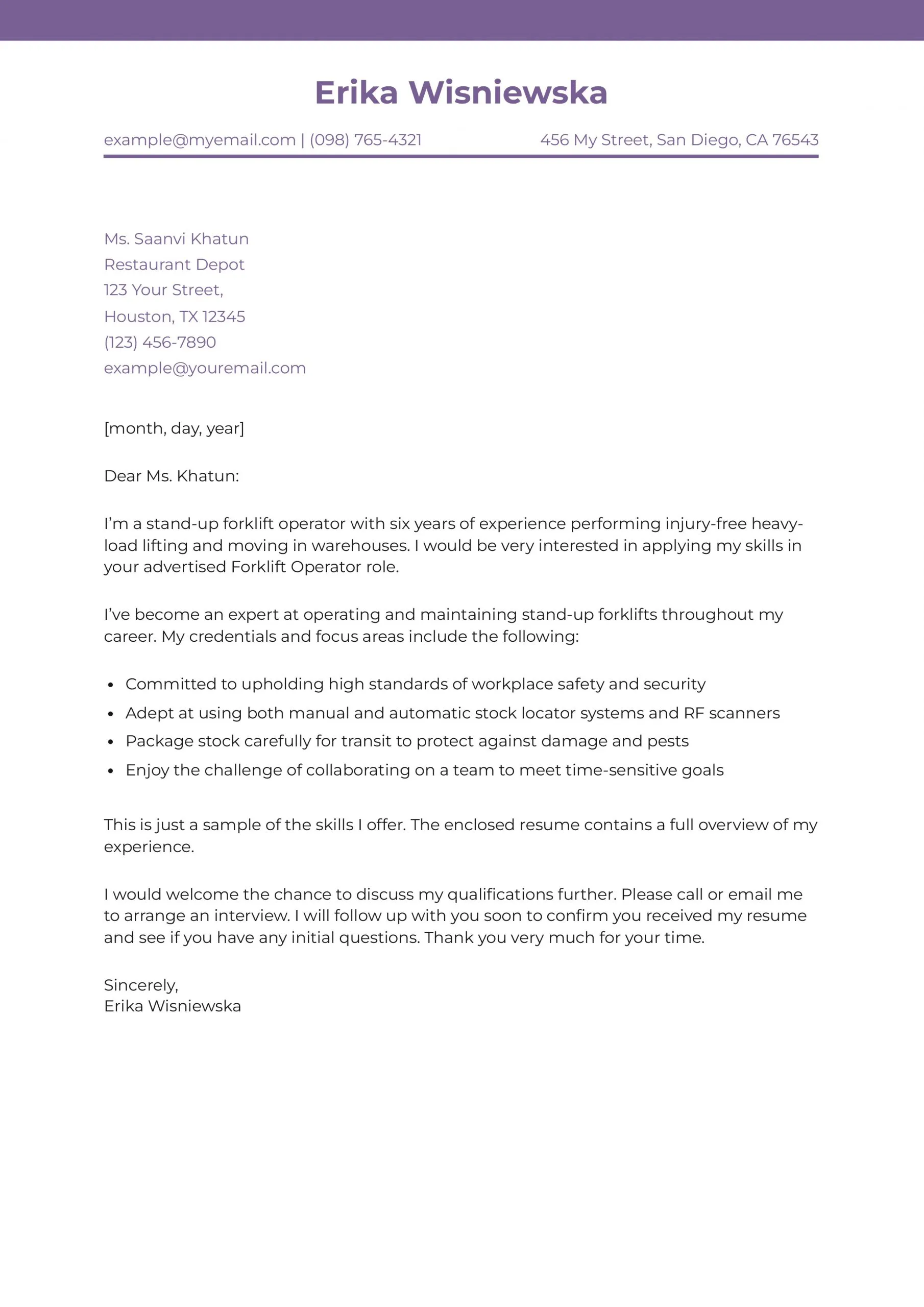
Instead of just listing your job responsibilities, quantify your accomplishments whenever possible. Use numbers and data to demonstrate your impact in previous roles. For example, instead of saying you ‘managed inventory,’ state that you ‘reduced inventory errors by 15% through the implementation of a new tracking system.’ If you increased the efficiency of loading and unloading, specify by how much (e.g., ‘Increased loading efficiency by 20%’). If you reduced workplace accidents or improved safety, include details (e.g., ‘Reduced workplace accidents by 30% in one year’). Quantifiable results make your resume more impactful and provide concrete evidence of your skills and achievements. This demonstrates to potential employers that you are results-oriented and can make a significant contribution to their organization. Use metrics to highlight your value and showcase the positive outcomes you achieved in previous positions.
Using Action Verbs to Describe Experience
When describing your experience, use strong action verbs to make your resume more dynamic and engaging. Action verbs effectively communicate what you did in your previous roles and show your capabilities. Examples of effective action verbs include ‘operated,’ ‘managed,’ ’loaded,’ ‘unloaded,’ ‘inspected,’ ‘maintained,’ ‘coordinated,’ ’trained,’ ‘improved,’ ‘reduced,’ ‘implemented,’ and ’ensured.’ Avoid using passive voice and focus on showcasing your active involvement in the tasks and responsibilities. For instance, instead of writing ‘Responsibilities included operating a forklift,’ write ‘Operated forklifts to transport materials.’ Action verbs bring your experiences to life and make your resume more memorable. Using action verbs also helps you to highlight your skills and achievements in a clear and concise manner, making your resume more appealing to potential employers.
Formatting and Design for Readability
The formatting and design of your resume play a crucial role in its readability and overall appeal. Choose a clean and professional layout, with clear headings and sections. Use a readable font size and style, such as Arial or Calibri, and maintain consistent formatting throughout the document. Use bullet points to list your responsibilities and accomplishments, making it easier for the hiring manager to scan the information. Avoid using excessive colors, graphics, or unnecessary design elements, as they can distract from your qualifications. Ensure there is sufficient white space to avoid a cluttered appearance. Proofread your resume carefully for any errors in grammar or spelling, as these can create a negative impression. A well-formatted resume demonstrates attention to detail and professionalism, increasing your chances of getting noticed by potential employers.
Cover Letter Essentials
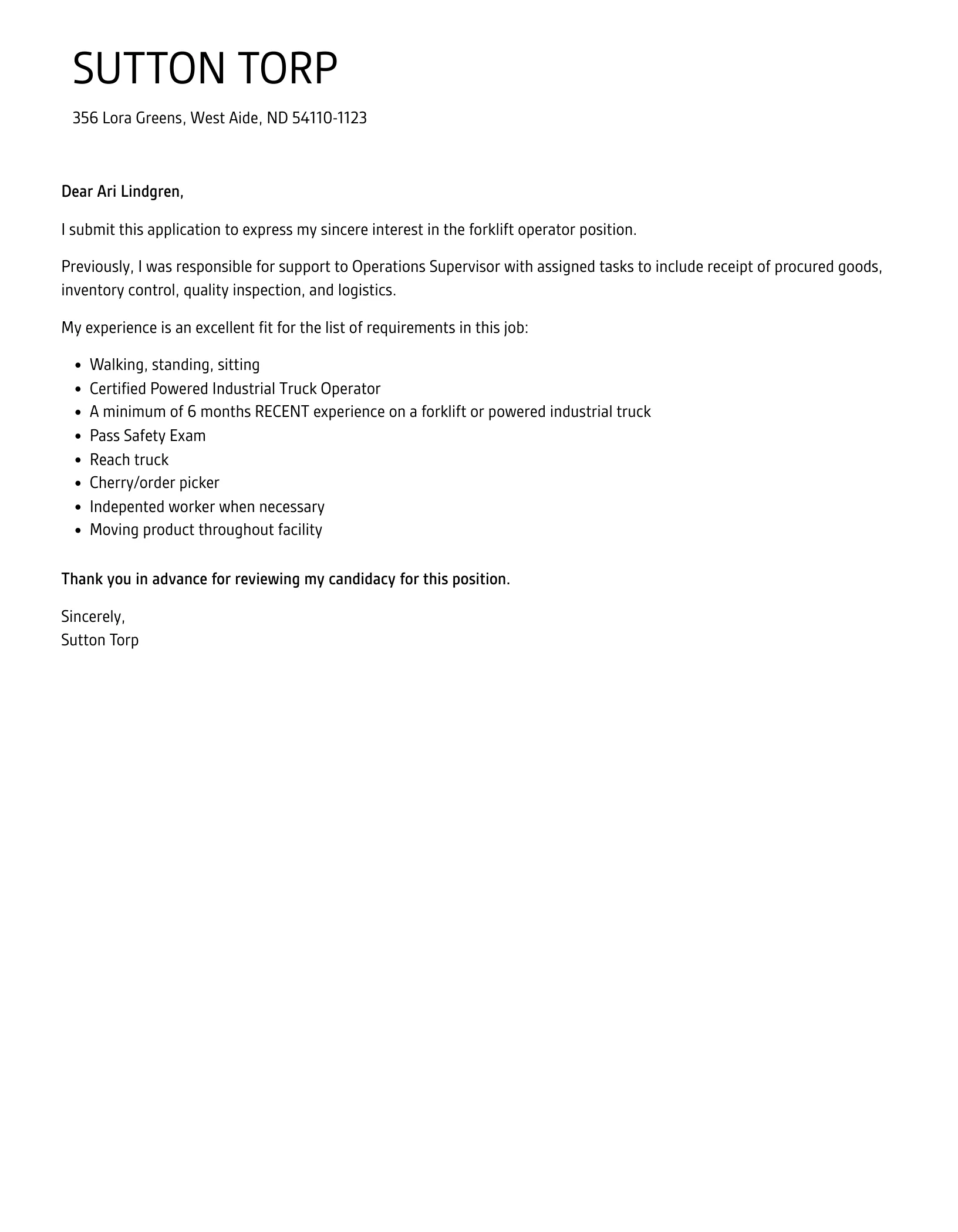
A well-written cover letter is essential for complementing your resume and making a strong impression. Your cover letter should be tailored to the specific job you are applying for, showcasing your understanding of the company and the role. Start by addressing the hiring manager by name if possible. Briefly introduce yourself and state the position you are applying for. Highlight your key skills and qualifications that align with the job description, using specific examples from your experience. Explain why you are interested in the company and what you can bring to the role. Keep your cover letter concise, focused, and easy to read. Conclude by expressing your enthusiasm for the opportunity and your willingness to provide further information. Always proofread your cover letter for any errors before submitting it. A well-crafted cover letter can significantly increase your chances of getting an interview.
Tailoring Your Cover Letter
Tailoring your cover letter for each job application is a crucial step that shows you’ve taken the time to understand the specific requirements of the role. Review the job description carefully and identify the key skills and qualifications the employer is seeking. In your cover letter, highlight the skills and experiences that directly match these requirements. Use keywords from the job description to show that you are a good fit for the position. Research the company to understand their values, goals, and culture. In your cover letter, explain why you are interested in the company and how your skills align with their objectives. Avoid using a generic cover letter template. Customize your letter to demonstrate your understanding of the company’s needs and your genuine interest in the position. This personalized approach makes a strong impression on the hiring manager and increases your chances of getting an interview.
Showcasing Your Enthusiasm and Fit
Your cover letter should showcase your enthusiasm for the position and the company. Express your genuine interest in the job and explain why you are excited about the opportunity. Highlight how your skills and experience align with the company’s needs and demonstrate your understanding of the role. Mention any specific achievements or contributions you have made in previous roles that are relevant to the job. Show that you have researched the company and are familiar with their products, services, or culture. Convey a positive and confident tone throughout your cover letter, and use language that reflects your personality and passion for the industry. If you know someone at the company, you can mention their name in your cover letter to indicate your connection. Showing enthusiasm demonstrates your genuine interest and makes a positive impression on the hiring manager.
Proofreading and Editing Your Documents
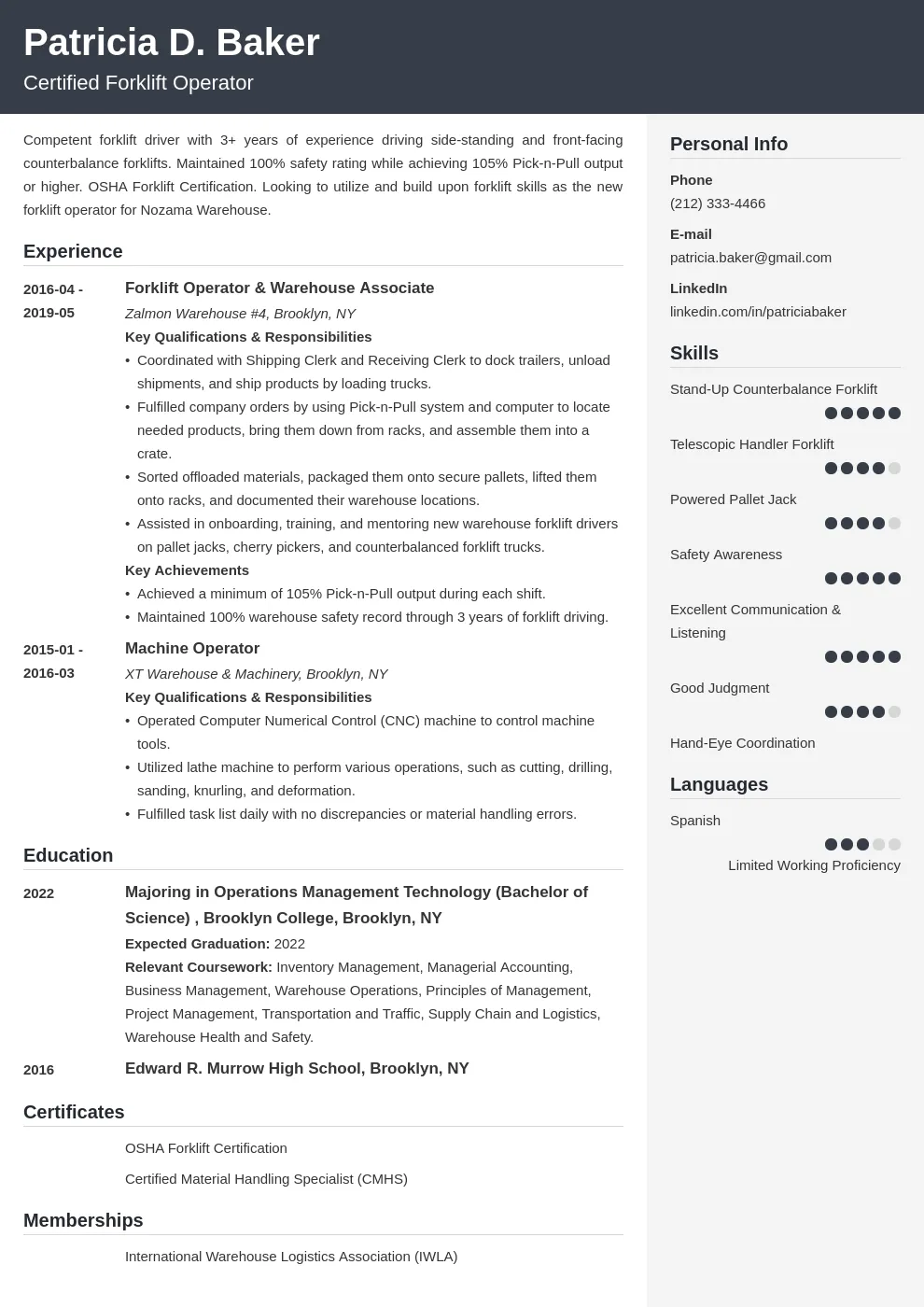
Before submitting your resume and cover letter, proofreading and editing are essential to ensure they are free from errors. Carefully review both documents for any mistakes in grammar, spelling, punctuation, and formatting. Read your documents aloud to help catch any awkward phrasing or unclear sentences. Have a friend or colleague review your documents as well, as a fresh pair of eyes can often spot errors that you may have missed. Pay attention to the overall flow and clarity of your writing. Ensure that your resume and cover letter are consistent in tone and style. Make sure the contact information is accurate and up-to-date. Correcting all errors before submitting your application demonstrates your attention to detail and professionalism, leaving a positive impression on potential employers. Proofreading is a critical step in the job application process, so don’t skip it.
Final Review and Submission
Before submitting your resume and cover letter, conduct a final review to ensure everything is perfect. Double-check all the details, including contact information, dates of employment, and the job title. Make sure your resume and cover letter are tailored to the specific job you’re applying for. Review the job description one last time to ensure you’ve addressed all the requirements and highlighted the relevant skills. Confirm that your documents are in the correct format and are easy to read. Save your documents with a professional file name (e.g., ‘Your Name - Resume’, ‘Your Name - Cover Letter’). If the job application requires specific file formats, make sure you have followed the instructions. Finally, submit your application through the designated channels. After submitting, keep a copy of your resume and cover letter for your records. Preparing and submitting a well-crafted resume and cover letter takes time and effort, but it is a critical step in your job search.
